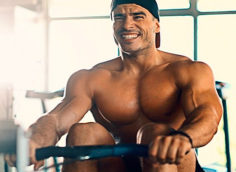Here's what you need to know...
- If your goal is to build bigger muscles and you already have a good base of strength, chasing PRs isn't going to add significant size.
- Heavy weight isn't that important for hypertrophy. The actual weight you're lifting has less to do with it than you may think.
- Before increasing the weight, increase ROM, alter tempo, or use extended set methods to trigger new muscle growth.
- Burnout sets and higher volume protocols are great alternatives to increasing weight.
- The experienced lifter knows when to deviate from his program and do what his body needs during a workout.
- The goal should be to make weights feel like they weigh more than they do.
Pure, Unapologetic Muscle Gains
Training for a sport and performance is a different beast compared to training for size. Ironically, many lifters today desperately want bigger muscles but have become handicapped by constantly striving for a new 1RM.
Given an ultimatum, most of these gym-going males would choose aesthetic size over strength, choosing to be built like Dwayne "The Rock" Johnson even if it meant they'd be capped at a 225-pound bench press for the rest of their lives. And yet they still chase one-rep maxes and avoid the more effective hypertrophy training techniques.
If your main goal is aesthetic size – big, impressive muscles – then this message is for you. Ready? Brace yourself.
Heavy weight isn't that important if you want to get bigger.
The goal, after all, is supposed to be to break your muscles down in the weight room, and then let them grow through nutrition and recovery. The weight you're actually lifting in one shot has less to do with it than most people are willing to believe.
How Strong Do We Really Need to Be?
Let's take a step back and objectively look at this issue. Most people want to lift crazy amounts of weight, and for good reason: there's nothing that feels better than a solid strength PR in a big lift.
And as far as big compound movements go – think squat, deadlift and overhead press – there should never be a "ceiling" as to how strong we should desire to be. But with that said, is there a base?
Strength and conditioning experts will always encourage a new lifter to strive to lift a certain multiple of his body weight – for example, a 1.5x body weight deadlift for a beginning lifter. Many non-competitive lifters want to get stronger for their health – to increase joint health and bone density – and they use strength as an indicator of progression. And of course, many want to get stronger for ego purposes.
But as far as the health side of things goes, would your life span be longer if you're benching 365 for a single instead of 275? Maybe. It's worth thinking about. But there's gotta be a point where we're "okay" to maintain.
Bringing things back to the pursuit of size, would lifting heavy and constantly focusing on increasing weight truly amplify the results you're seeking in strictly making your body larger than it used to be? If you're an advanced trainee, then no.
Sure, it helps to stimulate the nervous system and release testosterone and HGH, but research has suggested that high-rep sets can deliver a similar hormonal response.
Lee Haney used to say it's about stimulating the muscles, not annihilating them. If you're already at a level where your strength is nothing to laugh at, it means you were successful at developing a foundation. Given you're after size and muscle development, it's time to employ other methods.
The Myth of Progression
People always quantify "progression" as increasing the load they use to perform a given exercise for the same number of reps. There's no disputing that, but it seems that people fail to acknowledge that an increase in load isn't the only form of progress that should be worth note, especially when it comes to training for size.
Consider a typical set of 10 reps in a given bodybuilding movement. Before increasing the weight by 5-10% the next week and repeating, here are ways you might look at improving:
Added ROM
Increasing the range of motion will add more time under tension using the same load as before. Think deficit deadlifts, rear-leg elevated split squats with added ROM, or ass-to-the-grass squats if you've been in the habit of just breaking parallel.
Altered Tempo
It's definitely more challenging to lift weights while applying a slow eccentric or negative to each rep and set you do. Paused reps, 4-second negatives, and other tempo changes can create a whole new ballgame of stimulation for a working muscle. This is especially effective for pushing exercises.
Extended Set Methods
The rest/pause method, ladder sets, clustering methods, and 1.5 reps are just a few ways to make progressions with weight that won't even approach your max effort.
Again, if the name of the game is to get big, it's useful to change your thinking. All of the above points signify progression. "Big" and "strong" have some crossover, but in many ways they're not the same. Getting big is a different animal that requires a different outlook.

4 Tips for Putting On Size
If you've been performance-focused for a long time, have built up a good foundation of strength, and are ready to build some "bodybuilder muscle," here are four strategies that will work for you.
1. Focus on the Mind Muscle Connection
Many people have no idea how important it is to build a connection to the weights while you're lifting them. They go through the motions of a dumbbell bench press with weight that challenges their strength and they try to use good technique so they "feel it in the chest."
The truth is, you can use light sets and enhanced mental focus to achieve the same thing. You can forgo repping the 120-pound dumbbells for incline presses and use the 80's. Chances are, after time, you'll be the biggest you've been in years.
The goal should be to make weights feel like they weigh more than they do. You'll still find yourself as sore for three days after you get the hang of it. The same rules apply to many other exercises, including split squats, lateral raises, and chest flies.
2. Use High Volume Weeks
Sets of 6-8 reps won't cut it week after week. It becomes redundant and the nervous system begins to become less and less responsive to this kind of training. In this case, "high volume" mean more sets of exercises that include more reps.
Take a base movement like the squat or press and use a higher rep/lower rest scheme. It could be as simple as 6 x 10-12 with short rest intervals, or something more advanced and challenging like a Gironda 8 x 8 approach, the German Volume Training 10 x 10 method, or ladder sets, all of which use no more than 70% (and that's being generous) of max effort.
Again, it's important to remember what the goal is here. These workouts are to break muscles down and exhaust them appropriately to trigger growth in recovery.
3. Use Burnout Sets
Even during weeks where you're lifting for heavy triples, after your final work set, drop the weight down to around 60% of what you were using and rep it out. It should end up somewhere between 15 and 20 reps.
It serves as a good finisher, but more importantly, burnout sets can be a good way to boost lactate levels and stimulate the pituitary gland to release more HGH. Plus it gives your conditioning a kick in the pants.
4. Train Intuitively
It's a simple rule: Don't become a prisoner to your program.
It's easy to view the workout you have scheduled as the equivalent of a pile of paperwork on your desk that you need to get through before the day's done. Paperwork left on the desk means an incomplete job, and not a full day's work.
The thing is, if you're muscling reps up with no focus, feeling pain in a joint or two, and basically not getting any "worth" from your lifting, then there's no point in doing it in the first place. We all have workouts that don't "take." It's easy to just keep going through that bad workout even though you're feeling nothing in your target muscles.
It's a real sign of lifting maturity to deviate from your program and do what your body needs to get the most out of a workout. It could be as small as ditching dips from your workout for the day and replacing them with a French press. Maybe you feel like you're really "in the groove" on squat day, so why not tack on an extra set or two? Take advantage of the times you feel in the zone and be mindful of the times you don't.
Lastly, training intuitively sometimes it means ignoring the amount weight you're lifting and focusing on nothing other than the pattern and the stimulation (refer to tip #1). Don't even count your reps. Monitor your muscular output viscerally.
This is why you may see veteran bodybuilders come into the gym and do isolation workouts with extremely light weights sometimes. It's a valuable concept to recognize.





